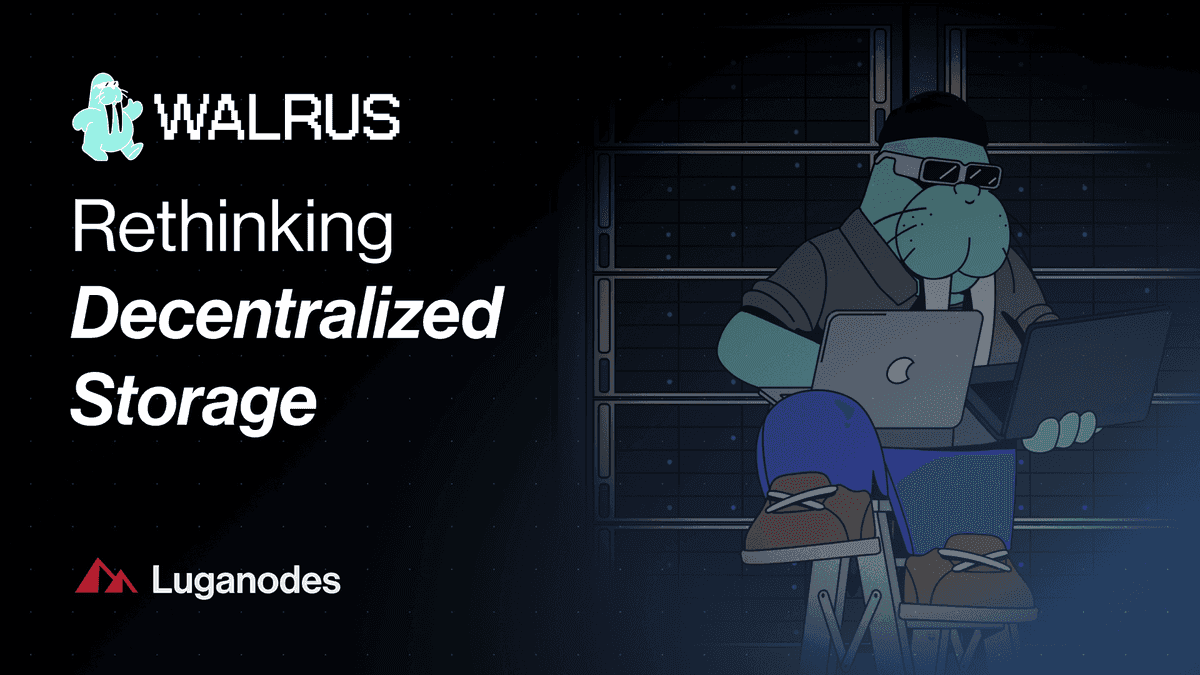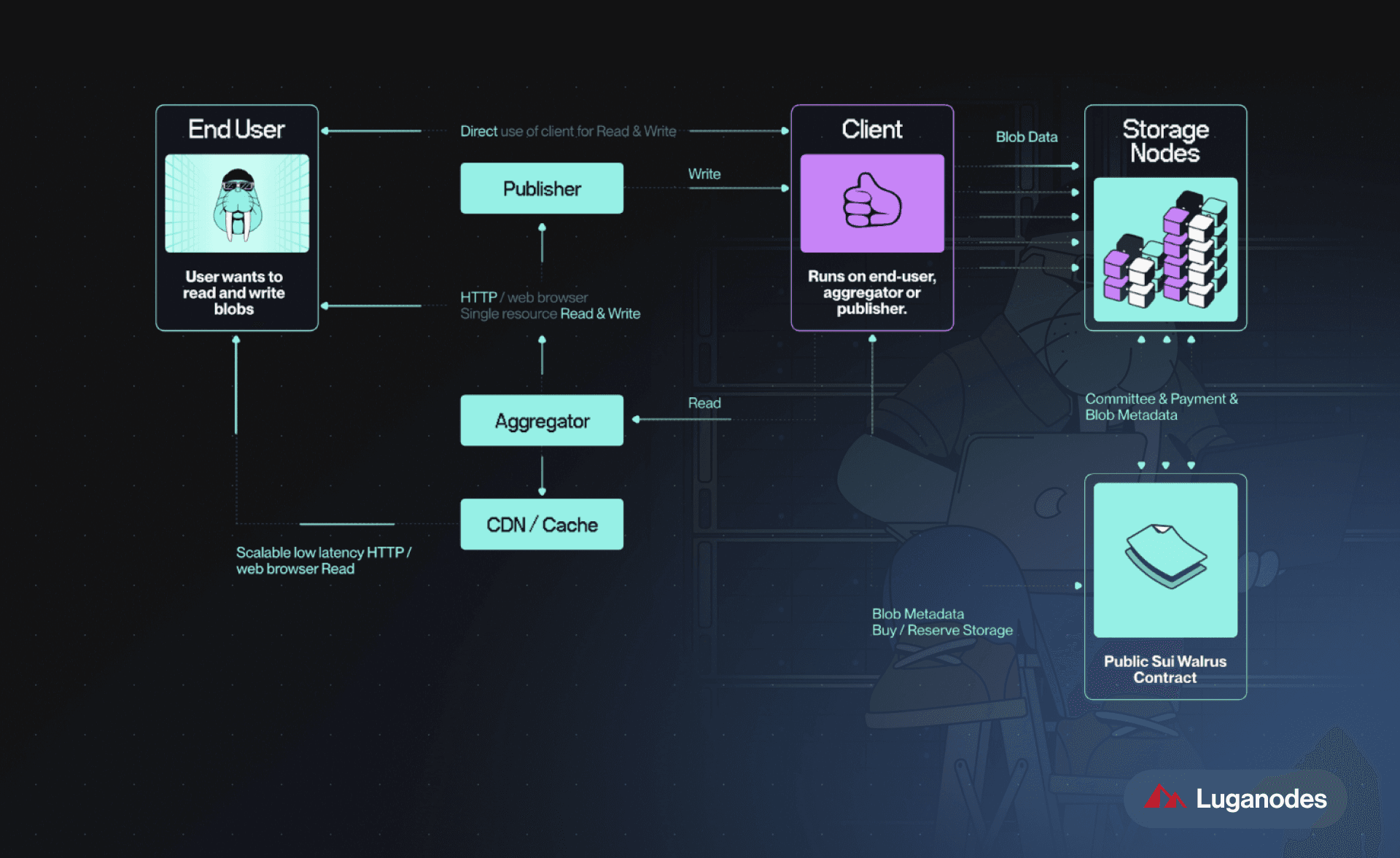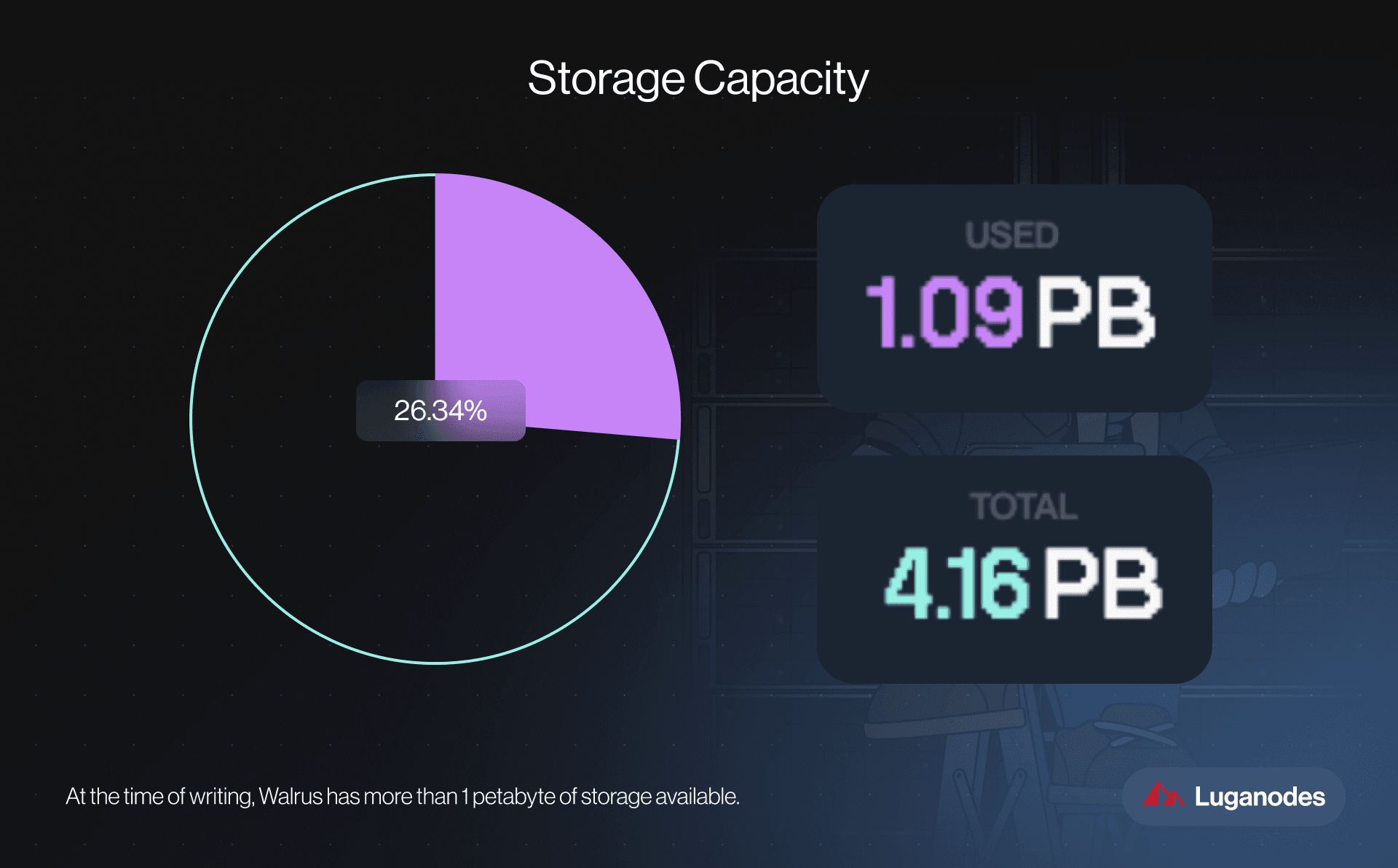7 min read
Walrus: Rethinking Decentralized Storage
Resilient Blob Storage

Introduction
In the ever-expanding universe of blockchain infrastructure, Mysten Labs—the team behind the high-performance Sui blockchain—has launched one of the most ambitious decentralized storage protocols yet: Walrus. It aims to redefine the way decentralized applications interact with data itself: how it’s stored, accessed, verified, and priced.
While most blockchains struggle to handle large volumes of unstructured data, Walrus is engineered from the ground up as a decentralized blob store—designed to be fast, cheap, verifiable, and resilient. It brings together advanced erasure coding, tight coordination with the Sui blockchain, and a clean separation of roles across users, storage nodes, aggregators, and publishers. Together, these components form a robust, permissionless protocol that supports everything from AI datasets and ZK-proofs to media-heavy dApps and blockchain history.
This article explores the architecture and features of Walrus in-depth, walking you through how it works, what makes it different, and why it’s a foundational primitive for Web3 builders.
The Problem Walrus Solves
Traditional decentralized storage networks enable you to store files off-chain. But they rarely guarantee that those files are available when you need them, or that someone else hasn’t tampered with the content. For mission-critical apps—think AI agents, rollups, decentralized frontends—this is unacceptable. These apps need to:
-
Store large binary data (blobs) like videos, models, snapshots
-
Access it reliably, even if part of the network fails
-
Verify availability without needing the whole file
-
Do all this cheaply and programmatically
Walrus addresses these needs by introducing a verifiable, resilient blob storage layer that runs independently but coordinates tightly with the Sui blockchain.
What is a Blob?
The term “blob” stands for Binary Large Object. It refers to data that can’t easily be structured into tables or simple key-value pairs: images, sound files, AI model weights, blockchain snapshots, or JavaScript files.
Walrus is purpose-built to store and retrieve these kinds of unstructured data in a decentralized way. Crucially, it also lets users and smart contracts verify whether a blob exists and is available for use—without needing to download it in full.
The User Journey: How a Blob is Stored and Verified
To understand Walrus, let’s walk through the steps that happen when a user wants to store a blob:
-
Upload: A user (or publisher) submits the blob to the Walrus network using a CLI, SDK, or Web2 interface.
-
Encoding: The blob is split into slivers using an erasure coding algorithm called Red Stuff, which encodes the file into smaller pieces spread across many storage nodes.
-
Distribution: Each sliver is assigned to a storage node within a given storage epoch. These nodes commit to storing and serving their assigned slivers.
-
Proof of Availability: Once the nodes acknowledge receipt, the user collects signed attestations and combines them into an availability certificate.
-
On-Chain Attestation: The user uploads the certificate to the Sui blockchain, where it becomes a permanent record of the blob’s availability.
-
Verification: Anyone (including smart contracts or light clients) can now verify the blob’s availability on-chain by referencing this certificate.
This mechanism allows Walrus to guarantee that blobs are retrievable—even if two-thirds of the storage network goes offline.

Under the Hood: Red Stuff, Slivers, and Shards
At the heart of Walrus’s efficiency is its erasure coding protocol, Red Stuff. It solves a fundamental tradeoff in decentralized storage between replication cost and data resilience.
Rather than duplicating entire blobs across nodes (which would be prohibitively expensive), Red Stuff breaks each blob into slivers. These slivers are then grouped into shards, which are stored across different storage nodes.
Red Stuff enables:
-
Self-healing recovery when nodes go down
-
Low bandwidth requirements for repair
-
Verifiability in asynchronous networks, which prevents malicious nodes from exploiting network delays
This approach yields high reliability at a fraction of the cost, with a typical replication factor of just 4.5x compared to full on-chain storage.
Epochs, Committees, and Coordination
Walrus divides time into epochs—two-week periods during which a rotating committee of storage nodes are responsible for:
-
Hosting shards
-
Responding to blob requests
-
Participating in audits
-
Managing on-chain price signals and availability proofs
At the end of each epoch, nodes are rewarded in $WAL, Walrus’s native token, for their service. High-performing nodes can gain eligibility to join the next epoch’s committee, adding a reputation layer to the system.
All these operations are mediated by smart contracts on Sui, making the protocol both programmable and auditable.

At the time of writing, Walrus has more than 1 petabyte of storage available.
Sui Integration: Storage Objects, Payments, and Blob Lifecycle
Walrus doesn’t operate in a vacuum. It’s deeply integrated with the Sui blockchain, which manages storage operations through a series of smart contracts and objects.
Each blob stored on Walrus is associated with a Sui object that tracks:
-
Its availability window
-
Its ownership and metadata
-
The amount of storage purchased
-
Whether it can be extended or deleted
Users use $WAL to lease space and pay storage providers, while $SUI is used to cover gas costs for on-chain operations. Smart contracts determine pricing, monitor availability, and let applications verify the presence of a blob.
This combination of off-chain storage with on-chain guarantees is what makes Walrus composable and trustworthy.
Use Cases: Why Walrus Matters
Walrus is not a generic file host—it’s purpose-built for blockchain-integrated applications that need large, verifiable data to function. Here’s where it shines:
-
AI & ML: Store training data, weights, model checkpoints, and outputs
-
Layer 2s & Rollups: Certify availability of data, proofs, and fraud logs
-
Decentralized Frontends: Host complete HTML, JS, and media stacks on-chain
-
Blockchain Archives: Store full historical data cheaply for reference and compliance
-
Creator Tools: Power subscription paywalls with encrypted media and verifiable access
Each of these use cases benefits from Walrus’s programmability, cost efficiency, and resilience.
Additional Infrastructure: Aggregators, Caches, Publishers
Walrus supports optional roles that improve performance and usability:
-
Aggregators: Reconstruct blobs from slivers and serve them via Web2 (HTTP)
-
Caches: Reduce latency and rebalance bandwidth, acting as CDN-like intermediaries
-
Publishers: Help users upload blobs via traditional interfaces, handling encoding and node coordination
These actors are permissionless, modular, and can be independently monetized, making the protocol more extensible and efficient.
Tokenomics: $WAL and $FROST
Walrus uses a dual-token setup:
-
$WAL is the native asset used to lease space and stake by storage nodes
-
$FROST is its smallest denomination (1 $WAL = 1B $FROST), used for precise accounting
Delegators can stake $WAL to nodes, and rewards are paid out based on performance metrics tracked across epochs.
Meanwhile, Sui validators remain responsible for executing on-chain logic and verifying availability certificates.
Availability and Authenticity
Data availability in Walrus is more than storage—it’s about trust. When a user stores a file, they receive a blob ID that maps directly to an encoded and signed data object. This guarantees:
-
The data exists
-
It hasn’t been modified
-
It’s available to the network
If the blob is unavailable or malformed, users can upload inconsistency proofs to Sui, triggering a cleanup event and revoking rewards from the offending storage node.
Governance and Roadmap
Looking forward, Walrus plans to implement:
-
Light-node rewards for partial storage
-
Attestation via probabilistic challenges
-
Epoch-level governance for node rotation
-
Subscription-based storage renewal
All these are designed to maintain Walrus’s core promise: low-cost, highly available storage with on-chain verifiability.
Conclusion: The Web3 Storage Layer, Reinvented
Walrus isn’t trying to rebuild AWS or re-implement a CDN. It’s not a smart contract platform. It’s a dedicated protocol for the one thing that all modern apps need: verifiable, programmable, decentralized storage.
Whether you're building an AI stack, a zkRollup, a media dApp, or a decentralized website, Walrus lets you store data affordably and prove it's available—without sacrificing decentralization or composability.
About Luganodes
Luganodes is a world-class, Swiss-operated, non-custodial blockchain infrastructure provider that has rapidly gained recognition in the industry for offering institutional-grade services. It was born out of the Lugano Plan B Program, an initiative driven by Tether and the City of Lugano. Luganodes maintains an exceptional 99.9% uptime with round-the-clock monitoring by SRE experts. With support for 45+ PoS networks, it ranks among the top validators on Polygon, Polkadot, Sui, and Tron. Luganodes prioritizes security and compliance, holding the distinction of being one of the first staking providers to adhere to all SOC 2 Type II, GDPR, and ISO 27001 standards as well as offering Chainproof insurance to institutional clients.
The information herein is for general informational purposes only and does not constitute legal, business, tax, professional, financial, or investment advice. No warranties are made regarding its accuracy, correctness, completeness, or reliability. Luganodes and its affiliates disclaim all liability for any losses or damages arising from reliance on this information. Luganodes is not obligated to update or amend any content. Use of this at your own risk. For any advice, please consult a qualified professional.